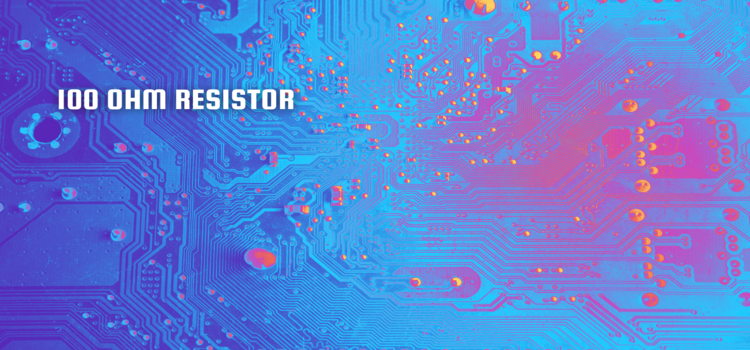A 100 ohm resistor is an electrical component used to limit the flow of current in a circuit. As the name suggests, it has a resistance value of 100 ohms, which means that it reduces the current by 1 ampere when a voltage of 100 volts is applied across it, according to Ohm's law.
Resistors are passive devices that dissipate energy in the form of heat. They are one of the most commonly used electronic components, finding applications in a wide range of electronic circuits. The primary function of a resistor is to control the current flow, prevent excessive current from damaging sensitive components, and divide voltage within a circuit.
The 100 ohm resistor is often used as a current-limiting resistor in various applications. For instance, it can be employed with light-emitting diodes (LEDs) to control the amount of current passing through them. LEDs require a specific current to operate within their safe operating range, and exceeding this range can cause them to fail. By incorporating a 100 ohm resistor in series with an LED, it helps regulate the current flowing through the LED, preventing any damage to it.
Additionally, the 100 ohm resistor can be used in voltage divider circuits. A voltage divider is a circuit that divides a given voltage into smaller fractions. By connecting a 100 ohm resistor in combination with another resistor, a desired output voltage can be obtained. This configuration is commonly utilized in signal-processing applications, such as audio amplifiers and communication systems.
Furthermore, 100 ohm resistors are frequently used in electronic testing and measurement equipment. They are used as known resistance values or calibration standards for verifying or calibrating other measuring devices. These resistors are typically manufactured with high accuracy to ensure precise resistance values.
In conclusion, a 100 ohm resistor is a widely used electrical component with a resistance value of 100 ohms. It serves as a current limiter, voltage divider, and calibration standard in various electronic circuits and systems. Its versatility and reliability make it an essential element in countless applications across different fields, including consumer electronics, telecommunications, automotive, and industrial sectors.

There are various types and configurations of 100 ohm resistors available in the market, each designed for specific applications and requirements. Some of the common types of 100 ohm resistors are:
1. Carbon Film Resistors: These resistors are made by coating a thin layer of carbon film on a ceramic base. They offer stability, accuracy, and reliability at an affordable price. Carbon film resistors are suitable for general-purpose applications, low-power circuits, and are often used in consumer electronics.
2. Metal Film Resistors: Metal film resistors are manufactured by depositing a thin layer of metal (typically nickel-chromium or tin-oxide) on a ceramic or glass base. They provide a higher level of accuracy, lower noise, better temperature stability, and a higher operating frequency range compared to carbon film resistors. Metal film resistors are commonly used in precision applications such as audio circuits, medical instruments, and instrumentation amplifiers.
3. Wirewound Resistors: Wirewound resistors are constructed by winding a resistive wire (usually nickel-chromium or copper-nickel) around an insulating core. They offer high power handling capabilities, low inductance, and excellent stability. Wirewound resistors are employed in high-power applications, power supplies, motor control circuits, and electronic equipment where precise control of electrical current is required.
4. Thick-Film Resistors: Thick-film resistors are produced by depositing a resistive paste on a ceramic or glass substrate and then heating it to form a thick resistive layer. They are cost-effective, offer good stability, and are suitable for high-volume production. Thick-film resistors find applications in various devices and circuits including automotive electronics, telecommunications, and consumer electronics.
5. Surface Mount Resistors (SMD): Surface mount resistors are smaller in size compared to their through-hole counterparts, making them ideal for compact electronic designs. SMD resistors can be of various types like chip resistors (thin-film, thick-film), array resistors, and network resistors. They are widely used in modern circuit boards, mobile devices, computers, and other portable electronics.
It is important to select the appropriate resistor type for your specific application, considering factors such as power rating, tolerance, temperature coefficient, and the desired level of precision. Additionally, it is advisable to refer to the manufacturer's datasheet or consult with an electrical engineer to ensure the correct selection of resistors for your project.